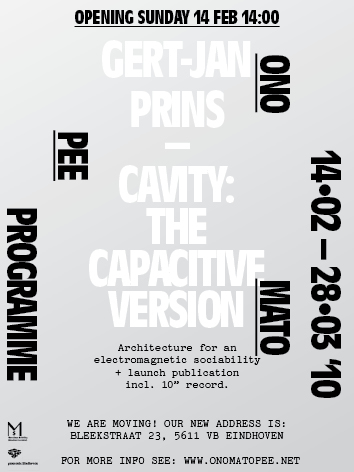Onomatopee 39: Gert-Jan Prins - Cavity: The capacitive version
Taking technological culture’s micro to a global macro level: architecture for electromagnetic sociability.
Sound artist Gert-Jan Prins (1961) deals with the frequencies of our electronic age. Between feedback and composition, between the free will of human improvisation and the determinism of electronic laws (and digital algorithms), Prins operates as a sculptor and an experimenting scientist .
Cavity: the Capacitive version is a new work in his study to bring forth the dynamics of this interplay within an architectural (atmo)sphere. The visitors, man, are brought about into this sphere as an electromagnetic wave. Do our bodies and minds indeed integrate into the mechanical and (digital) electro-technical order of our cultivation?
If indeed so, what would this mean to our sociability? Will we indeed experience a growing presence of the Asperger syndrome, as registered in areas as Silicon Valley and the Eindhoven Brainport region? Will this become a new standard for a post-mechanical, post-digital era? How can we discern this new order and precede this domain so as to anticipate it?
The technical meaning of a cavity is a small device with input and output. Within its hollow body, electromagnetic waves reflect, resonate, are clarified or amplified. Tuning is provided by a mounted capacitor.
Prins will build a cavity on human scale; the capacitive element, the filter, is represented in an interior system of sonically wrapped walls made from huge copper clad circuit boards.
Visitors are temped to enter this cavity as an electromagnetic wave. How do we socialise as such?
+
Gert-Jan Prins: Reduced Objects
‘A liberation of the machine’, the pathos often caused by sound and video experiments. While working on his self built sound tools, Prins became visually intrigued by these hidden inner-machine worlds, consisting of elements from electronic measuring equipment. Reduced Objects are studies on the interior architecture of electronic machines in a relation to his sound systems.
Every machine beholds an interior landscape, normally invisible and disregarded as such, as we solely tend to take its functional exterior into account. Many artists, driven by both a romantic and a technological fascination, related to the machine and its era: from Leonardo Da Vinci in the 17th century to 20th century Futurists to present day geeks.
To voice the inner world of electronic hardware like radios, video recorders, computer games etc., the machine should, according to the machine liberators, take its true matter into account: both on behalf of its inner, private sounds as its visual existence. As all of these are the side effects of a functional destiny, they are both part of our universal full sum and independent entities, sometimes even ignored.
In a role that could be pronounced as 'electronic archeologist', Prins stripped hardware, separating the electronic components, until bare frameworks, with a specific body to voice, remained. This particle configuration and (de)assembling of industrial nature's elementary presents us the series of Reduced Objects.
